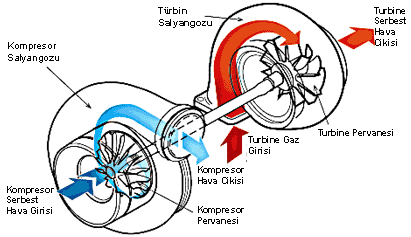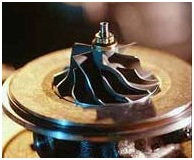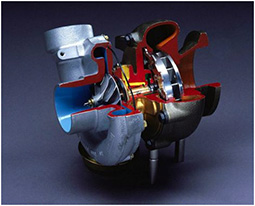WHAT IS TURBOCHARGER?
 In simple terms, a turbocharger is a radial fan pump that contains a gas compressor and a turbine. It is used to create forced-induction in an internal combustion engine. Similar to a supercharger, a turbocharger is designed to cause more mass of air to go into the engine. This causes the engine to have more power. The difference between a turbocharger and a supercharger is that the turbocharger’s compressor is run by a turbine which runs on the engine’s exhaust gases.
In simple terms, a turbocharger is a radial fan pump that contains a gas compressor and a turbine. It is used to create forced-induction in an internal combustion engine. Similar to a supercharger, a turbocharger is designed to cause more mass of air to go into the engine. This causes the engine to have more power. The difference between a turbocharger and a supercharger is that the turbocharger’s compressor is run by a turbine which runs on the engine’s exhaust gases.
 HOW IT WORKS
HOW IT WORKS
 The turbocharger is bolted to the exhaust manifold of the engine. The exhaust from the cylinders spins the turbine, which works like a gas turbine engine. The turbine is connected by a shaft to the compressor, which is located between the air filter and the intake manifold. The compressor pressurizes the air going into the pistons.
The turbocharger is bolted to the exhaust manifold of the engine. The exhaust from the cylinders spins the turbine, which works like a gas turbine engine. The turbine is connected by a shaft to the compressor, which is located between the air filter and the intake manifold. The compressor pressurizes the air going into the pistons.


 How a Turbocharger is Plumbed In a Car
How a Turbocharger is Plumbed In a Car
 The exhaust from the cylinders passes through the turbine blades, causing the turbine to spin. The more exhaust that goes through the blades, the faster they spin.
The exhaust from the cylinders passes through the turbine blades, causing the turbine to spin. The more exhaust that goes through the blades, the faster they spin.


 insıde a turbocharger
insıde a turbocharger
 On the other end of the shaft that the turbine is attached to, the compressor pumps air into the cylinders. The compressor is a type of centrifugal pump. It draws air in at the center of its blades and flings it outward as it spins.
On the other end of the shaft that the turbine is attached to, the compressor pumps air into the cylinders. The compressor is a type of centrifugal pump. It draws air in at the center of its blades and flings it outward as it spins.


 turbo compressor blades
turbo compressor blades
 In order to handle speeds of up to 150,000 rpm, the turbine shaft has to be supported very carefully. Most bearings would explode at speeds like this, so most turbochargers use a fluid bearing. This type of bearing supports the shaft on a thin layer of oil that is constantly pumped around the shaft. This serves two purposes: it cools the shaft and some of the other turbocharger parts, and it allows the shaft to spin without much friction.
In order to handle speeds of up to 150,000 rpm, the turbine shaft has to be supported very carefully. Most bearings would explode at speeds like this, so most turbochargers use a fluid bearing. This type of bearing supports the shaft on a thin layer of oil that is constantly pumped around the shaft. This serves two purposes: it cools the shaft and some of the other turbocharger parts, and it allows the shaft to spin without much friction.

BENEFITS OF THE TURBOCHARGER
 Ever more stringent emissions regulations across the world are challenging automotive manufacturers to create engines that meet the needs of the environment whilst still satisfying the demands of consumers for vehicles that are fun to drive.
Ever more stringent emissions regulations across the world are challenging automotive manufacturers to create engines that meet the needs of the environment whilst still satisfying the demands of consumers for vehicles that are fun to drive.
 Honeywell Turbo Technologies is working closely with its customers on partnership programs that focus on engine downsizing, emissions control and fuel economy – but not at the expense of driveability.
Honeywell Turbo Technologies is working closely with its customers on partnership programs that focus on engine downsizing, emissions control and fuel economy – but not at the expense of driveability.
 These goals are complementary and bring together the performance qualities to make an automobile safe, clean and fun to drive. Honeywell turbochargers deliver significant benefits to end users:
These goals are complementary and bring together the performance qualities to make an automobile safe, clean and fun to drive. Honeywell turbochargers deliver significant benefits to end users:
 Safer: A turbocharged engine can generate as much as 7 times more power than a naturally aspirated (non-turbocharged) engine of equivalent displacement. In more standard applications, it is realistic to double the power of a given engine through turbocharging, making vehicles more responsive and safer to drive. Turbochargers also prevent the loss of power at high altitudes, thus providing significant advantages to turbocharged trucks and off-road machinery.
Safer: A turbocharged engine can generate as much as 7 times more power than a naturally aspirated (non-turbocharged) engine of equivalent displacement. In more standard applications, it is realistic to double the power of a given engine through turbocharging, making vehicles more responsive and safer to drive. Turbochargers also prevent the loss of power at high altitudes, thus providing significant advantages to turbocharged trucks and off-road machinery.
 More economical: Turbochargers harness and recycle the energy produced by automobile engines, transforming more of the fuel energy consumed into power by creating less parasitic heat and friction. As a result, turbocharged engines deliver significant fuel cost advantages over their naturally-aspirated counterparts.
More economical: Turbochargers harness and recycle the energy produced by automobile engines, transforming more of the fuel energy consumed into power by creating less parasitic heat and friction. As a result, turbocharged engines deliver significant fuel cost advantages over their naturally-aspirated counterparts.
 Greener: Because a turbocharger delivers more air to the engine, fuel combustion is easier, more thorough and therefore cleaner. Today’s turbocharged diesel engines produce 50% less NOx and CO2 emissions than conventional engines.
Greener: Because a turbocharger delivers more air to the engine, fuel combustion is easier, more thorough and therefore cleaner. Today’s turbocharged diesel engines produce 50% less NOx and CO2 emissions than conventional engines.
< Previous Page
